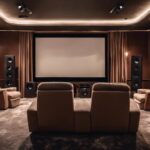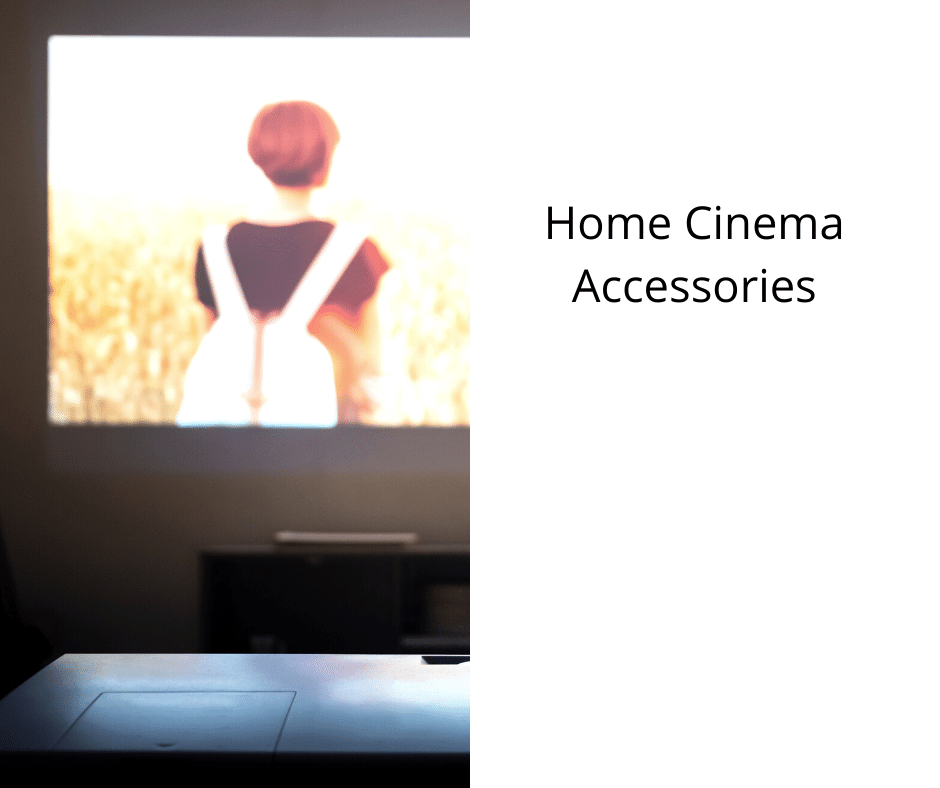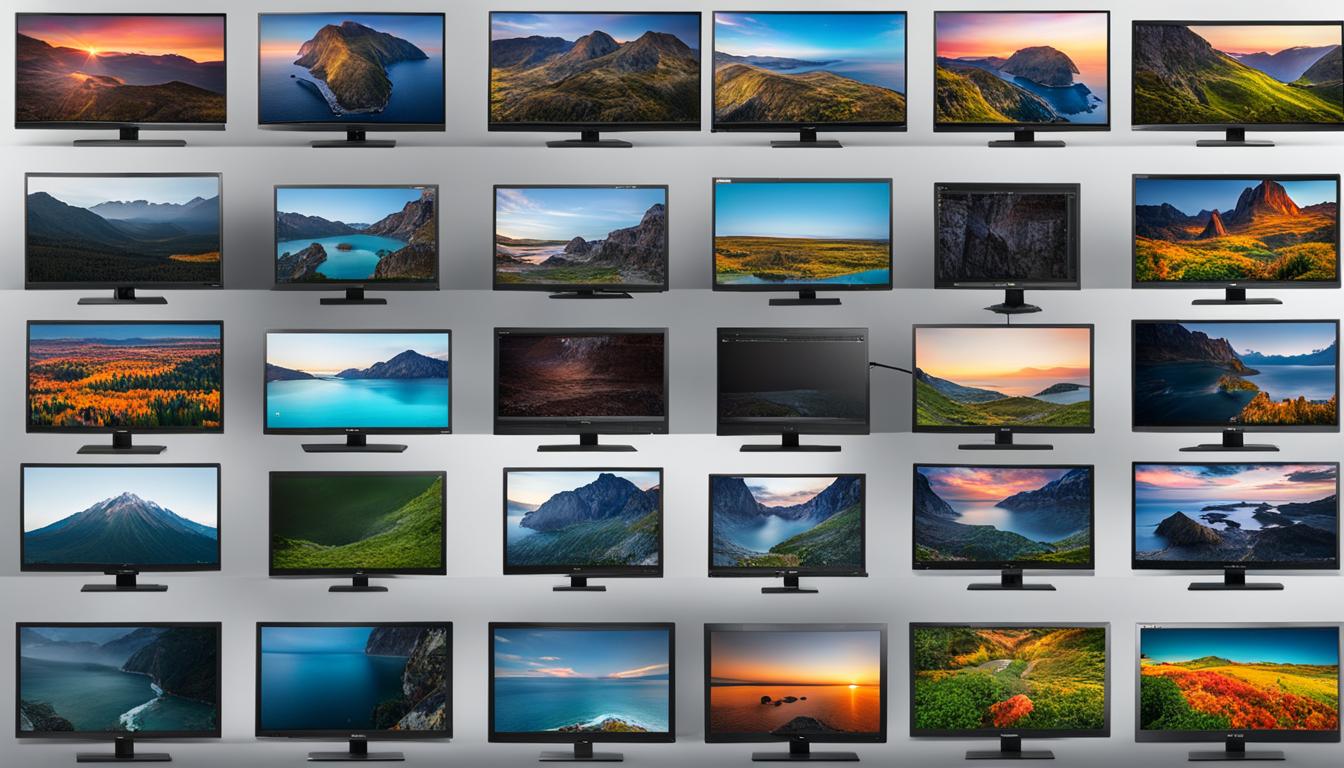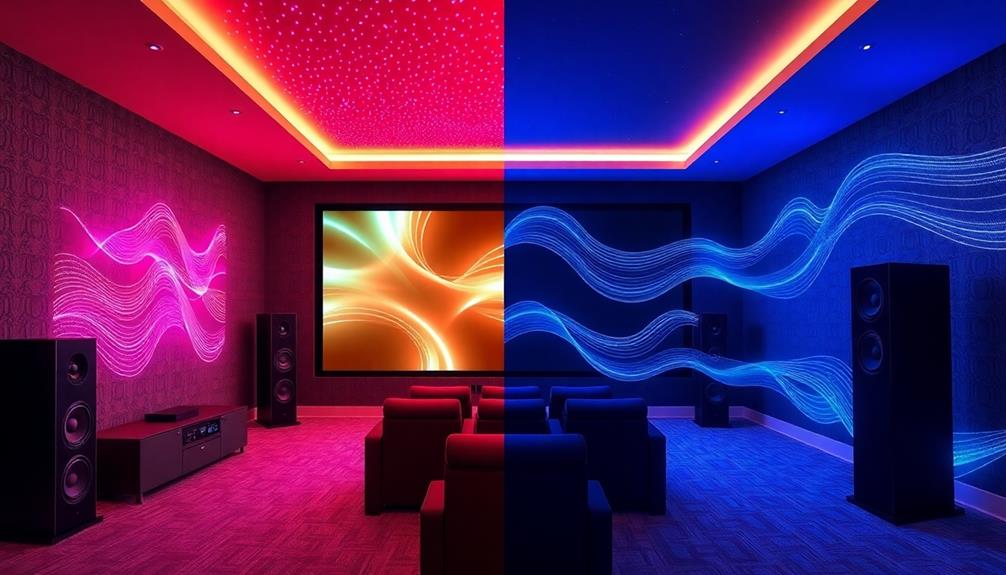To reduce noise in your home theater from your DIY projector, start by understanding sound transmission. Use effective materials like mass-loaded vinyl and acoustic panels to tackle low-frequency sounds. Decoupling techniques, such as resilient channels, minimize vibrations that travel through walls. Adding rubber dampening agents will further insulate against noise. You can enhance the enclosure by lining it with sound-dampening materials for better airflow management and reduced fan noise. Finally, consider strategic placement of bass traps to improve sound clarity. There's plenty more to learn about optimizing your setup for a truly immersive experience.
Key Takeaways
- Use mass-loaded vinyl and double-layered drywall to effectively block low-frequency sounds in your home theater.
- Incorporate acoustic panels and bass traps to absorb high frequencies and dampen low-frequency sounds for improved audio quality.
- Implement decoupling techniques, like resilient channels, to minimize structure-borne sound transmission between walls and frames.
- Ensure proper airflow management in projector enclosures using internal fans and sound-dampening materials to prevent overheating and reduce noise.
- Utilize rubber dampening agents and secure mounting techniques to absorb vibrations and stabilize the projector for a quieter experience.
Understanding Sound Transmission

When you think about sound transmission, it's important to recognize that sound travels as longitudinal waves through the air, compressing and transferring energy between particles. This process can be influenced by various surfaces and materials within your home theater.
One significant aspect to take into account is structure-borne sound, which is generated by vibrating materials and can travel faster than airborne sound. This means it can penetrate walls more effectively, especially at lower frequencies, making it essential to address in your soundproofing efforts.
To measure how well sound insulation works, look at the Sound Transmission Class (STC) rating. Higher STC values indicate better soundproofing, and for home theaters, a minimum STC of 50 is recommended.
Many common materials, like standard drywall, absorb high and mid-range frequencies well but struggle with those low-frequency sounds.
To effectively manage sound transmission, you need to combine various soundproofing techniques. Absorption, blocking, and decoupling are critical strategies to minimize both airborne and structure-borne noise, ensuring you can enjoy your home theater without unwanted interruptions.
Challenges With Low Frequencies

Low-frequency sound waves pose considerable challenges in soundproofing due to their ability to penetrate walls more effectively than higher frequencies. This means that traditional soundproofing materials often fall short when it comes to blocking these pesky low-end frequencies.
Many residential setups struggle with this, as the International Building Code (IBC) recommends a minimum Sound Transmission Class (STC) of 50 to effectively reduce low-frequency sounds. However, achieving this can be tricky. Understanding how various materials impact sound quality, like the benefits of air purifiers, can also play a role in creating a quieter environment.
While adding dampened drywall might raise the STC rating to around 52, conventional STC tests frequently overlook low-frequency performance. This gap can leave you frustrated, as you might still hear those rumbling bass notes.
To tackle this issue, consider using mass-loaded vinyl, which can greatly enhance sound isolation. Specialized techniques, like decoupling walls or using acoustic panels designed for low frequencies, can also help.
Ultimately, addressing low-frequency sound waves requires a more tailored approach than conventional methods. By understanding these challenges and implementing effective solutions, you can create a more enjoyable and quieter home theater experience.
Don't underestimate the importance of focusing on low frequencies in your soundproofing efforts.
Effective Soundproofing Materials

Addressing low-frequency challenges in soundproofing requires selecting the right materials to effectively manage sound transmission. One of the most effective soundproofing materials you can use is mass-loaded vinyl. This dense material blocks low-frequency sounds, making it perfect for your soundproof home theater.
Additionally, incorporating energy-efficient systems like geothermal heat pumps can enhance overall comfort, as they provide consistent indoor temperatures while reducing energy costs.
In addition to mass-loaded vinyl, consider using acoustic panels made from fiberglass or foam. These panels absorb high and mid-range frequencies, improving overall sound quality by reducing echo and reverberation.
For your walls, double-layered drywall, especially when combined with damping compounds, can greatly elevate the Sound Transmission Class (STC) rating, enhancing sound isolation in projector enclosures.
Don't overlook the flooring; rubber mats or underlayments can dampen impact noise and sound transmission, contributing to a quieter environment.
Finally, if you're involved in wall construction, resilient channels and sound isolation clips can help decouple drywall from the framing. This technique effectively minimizes structure-borne sound transfer, ensuring your home theater remains a peaceful retreat.
Decoupling Techniques and Hardware

Decoupling techniques are vital for achieving effective soundproofing in your home theater. By using methods like resilient channels and sound isolation clips, you can minimize structure-borne sound transmission between drywall and studs. This prevents noise from traveling through the building's framework, considerably enhancing your viewing experience.
Installing double wall systems or floating ceilings can also dramatically improve soundproofing effectiveness. These setups separate adjoining surfaces, reducing vibrational connections that typically allow sound to leak through. The key is to create an air gap with decoupling hardware, which disrupts sound waves and lowers transmission, making it ideal for your home theater.
When you choose and install the right decoupling materials, you can increase the Sound Transmission Class (STC) rating of your walls. This means they'll be more effective at blocking sound, essential for maintaining a quiet environment during movie nights.
Combining these decoupling techniques with other soundproofing methods, such as absorption and damping, creates a thorough strategy to soundproof a home theater effectively. With these approaches, you'll enjoy an immersive sound experience without the distraction of outside noise.
Acoustic Control Strategies

Once you've laid the groundwork for sound isolation with decoupling techniques, it's time to focus on acoustic control strategies that enhance the overall audio experience in your home theater.
These strategies help manage sound waves, reduce resonance, and improve clarity. For instance, utilizing proper equipment such as projectors with high refresh rates can also enhance the audio-visual experience, making sound quality even more essential.
Here are three effective methods:
- Acoustic Panels: Install panels on walls to absorb sound, especially in areas where echoes are prevalent. Consider using acoustic sealant around the edges to guarantee a tight fit.
- Bass Traps: Place bass traps in the corners of your room. These will dampen low-frequency sounds that can muddy your audio quality, providing a clearer listening experience.
- Upholstered Seating: Opt for upholstered seating instead of hard surfaces. The packed fibers in upholstery help minimize sound reflections, further enhancing the audio clarity during your movie nights.
Combining these elements with soft fabrics and carpets will create a well-rounded acoustic environment.
Proper placement and design of these treatments are vital, so take your time planning to optimize the sound quality in your home theater.
Enclosure Design for Projectors

When you design an enclosure for your projector, keeping airflow in mind is essential to prevent overheating.
Choosing the right materials and implementing effective thermal dissipation techniques will enhance both safety and performance.
Airflow Management Strategies
To guarantee your DIY projector operates efficiently, effective airflow management is vital, especially in enclosed designs. Poor airflow can lead to overheating, compromising performance and longevity.
Here are three strategies to enhance airflow while managing sound:
- Install Additional Fans: Rely on external fans to create a consistent airflow. Make sure they're strategically placed to counteract heat pooling around the projector.
- Utilize Dynamic Fan Speeds: Implement fans with adjustable speeds that respond to internal temperatures. This allows for maximum cooling without excessive noise, keeping your home theater peaceful.
- Select Sound-Dampening Materials: Incorporate materials like Alubutyl in the enclosure. This helps absorb sound while allowing for adequate ventilation, striking a balance between noise control and thermal management.
Using these strategies, you'll not only improve airflow but also make sure your projector operates within safe temperature limits.
Remember, maintaining a well-ventilated environment is essential to avoid overheating and prolong the projector's life while minimizing disruptive sounds.
With careful planning, you can enjoy your home theater experience without the stress of overheating or excessive noise.
Material Selection for Enclosures
Effective airflow management directly influences your enclosure's material selection. When designing your projector enclosure, you'll want to prioritize flame-resistant materials to guarantee safety, particularly since projectors like the BenQ TH670 generate substantial heat.
Using materials made from robust, heat-resistant compounds can help mitigate risks associated with overheating.
To enhance sound dampening, consider lining your enclosure with Alubutyl. This material is excellent for reducing vibrations and improving overall sound quality.
Additionally, incorporating rubber dampening agents can effectively minimize vibration noise, outperforming foam in this regard.
Don't overlook the need for proper airflow. If you're adding fans to your enclosure, verify they're positioned strategically to maintain ideal airflow.
Remember, internal fans aren't designed to handle restricted air paths, which can lead to overheating.
Lastly, while you focus on soundproofing, keep in mind that any material made should also facilitate heat dissipation.
Aluminium sound deadening can be a great option, providing durability and effective noise reduction while still allowing for necessary airflow.
Thermal Dissipation Techniques
Incorporating thermal dissipation techniques into your projector enclosure design is crucial for maintaining ideal performance and preventing overheating. By guaranteeing proper airflow, you can markedly reduce the risk of heat pooling, which can damage your projector.
Here are three key strategies to take into account:
- Add Extra Fans: Installing additional fans helps promote airflow, keeping the internal temperature in check. Make sure they're strategically placed to avoid air path restrictions.
- Dynamic Fan Speeds: Utilize fans that can adjust their speeds based on the temperature. This adaptability keeps the enclosure cool without generating unnecessary noise, an important factor since sound travels through the air.
- Flame-Resistant Materials: Choose flame-resistant materials for your enclosure to guarantee safety. High heat is a common byproduct of projector operation, and this extra layer of protection can prevent potential fires.
Vibration and Noise Mitigation

To keep your projector running quietly, you'll want to focus on effective vibration dampening materials and noise reduction techniques.
Using rubber sheets or Alubutyl adhesive can absorb vibrations, while covering reflective surfaces helps minimize sound reflection.
Don't forget to experiment with fan configurations to find the quietest setup for your projector.
Effective Vibration Dampening Materials
Reducing vibrations in your DIY projector setup can greatly enhance your home theater experience. By using effective vibration dampening materials, you can substantially minimize noise caused by projector vibrations, leading to improved sound quality.
Here are three excellent options to take into account:
- Rubber Sheets: Place rubber sheets beneath your projector to absorb vibrations. This not only reduces noise transmission but also stabilizes the projector.
- Alubutyl Adhesive: Apply Alubutyl adhesive to reflective surfaces. This material effectively dampens vibrations and is particularly useful in minimizing high and mid-range frequencies.
- Acoustic Foam Panels: Attach acoustic foam panels to the projector's bottom. They help block higher-frequency fan noise while ensuring proper airflow for cooling.
To further enhance performance, think about using double-sided tape or screws to secure rubber mounts. This approach minimizes structure-borne noise transmission to surrounding surfaces.
Additionally, testing different fan configurations can help optimize airflow and reduce internal noise levels. By incorporating these materials and techniques, you'll create a quieter and more immersive home theater environment.
Noise Reduction Techniques
When it comes to creating a quiet DIY projector setup, employing effective noise reduction techniques is essential for an immersive viewing experience. Start by using rubber dampening agents or sheets to effectively dampen vibrations and reduce noise from your projector. These materials outperform foam when it comes to isolating sound waves.
For added vibration control, apply Alubutyl adhesive to projector surfaces and secure rubber mounts with double-sided tape or screws.
Next, cover reflective surfaces, like plasterboard, to minimize noise transmission. You can also incorporate barriers, such as shelves, to block sound from reaching your seating area.
To tackle internal noise, consider utilizing higher airflow fans with lower noise ratings, and employ Smart Eco profiles to maintain minimum RPMs for quieter operation.
Experiment with different fan configurations and use duct tape to test noise level changes. This approach can lead to better thermal management and further reduce projector noise in enclosed spaces.
Thermal Management Considerations

Effective thermal management is essential for guaranteeing your DIY projector operates efficiently and safely. Without proper heat dissipation, your projector could overheat, leading to performance issues or even damage.
Here are three key considerations to keep in mind:
- Enclosure Design: Choose flame-resistant materials for your projector enclosure to enhance safety. Confirm it allows for adequate airflow; internal fans alone may struggle with added restrictions.
- Airflow Mechanisms: Incorporate additional fans to improve airflow within the enclosure. Dynamic fan speeds are highly recommended, as they adjust to internal temperatures, effectively regulating heat.
- Model-Specific Considerations: Consider the specific model and structure of your projector when designing the enclosure. Inadequate thermal management can compromise its performance, so tailor your design accordingly.
Practical DIY Soundproofing Tips

To create a quieter home theater experience, soundproofing your DIY projector is essential. Start by attaching 2×2 acoustic foam panels to the bottom of your projector. This helps block high-frequency fan noise while still allowing for airflow, considerably reducing distractions.
Next, consider lining the inside of your projector's cabinet with Alubutyl. This material dampens vibrations more effectively than foam and enhances sound quality due to its fire-resistant properties.
You can also construct a sound barrier using a solid wood piece lined with foam. This setup absorbs ceiling-reflected sound and blocks direct noise from reaching your listening area, thereby improving your overall viewing experience.
Additionally, install rubber dampening agents or sheets on your projector to mitigate vibrations that contribute to noise. Make sure to use double-sided tape or screws for secure mounting.
Frequently Asked Questions
How Do I Make My Projector Less Noisy?
To make your projector less noisy, consider adding acoustic foam panels, using a solid wood barrier, or lining with Alubutyl. You can also adjust fan speeds and use rubber dampening materials to minimize vibrations.
How to Muffle the Sound of a Projector?
"Silence is golden." To muffle your projector's sound, attach acoustic foam, use a wood barrier, incorporate Alubutyl, and test quieter fans. Each step helps you create a more enjoyable viewing experience without distractions.
Do Projector Hush Boxes Work?
Yes, projector hush boxes work effectively. They contain sound and can reduce noise levels considerably. By using proper materials and ensuring adequate airflow, you'll enhance your viewing experience without distracting projector noise interfering.
What Is Noise Reduction in a Projector?
Noise reduction in a projector involves minimizing sound from internal fans and components. You can achieve this by using acoustic materials, barriers, and rubber dampeners, ensuring your viewing experience remains immersive and distraction-free.
Conclusion
Imagine your home theater as a serene oasis, where the roar of the outside world fades into whispers. By embracing soundproofing techniques, you're crafting a sanctuary—a fortress for your cinematic dreams. Each layer of insulation is like a guardian, shielding your cherished moments from interruptions. As you commence on this DIY journey, remember that every small effort brings you closer to a world where every note and whisper dances freely, unhindered by the chaos beyond your walls.
Hi, I’m Dominique. I love movies and want everyone to have the best home cinema experience possible. That’s why I started 1home Theatre Projector. We help people build their home cinema system using the latest technology and news on laser tv and all-around home entertainment.
We’re a small team of movie buffs (and experts) who are passionate about giving our readers the best advice and information possible. So whether you’re just starting out or you’re looking to upgrade your home cinema system, we’ve got you covered!
















